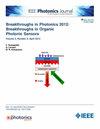Phase Response Identification of Photodetectors in High-Speed Interferometry Using Photoelectric Pseudorandom Signals
IF 2.4
4区 工程技术
Q3 ENGINEERING, ELECTRICAL & ELECTRONIC
引用次数: 0
Abstract
Dynamic accuracy and synchronization of high-speed interferometry are crucial for advanced manufacturing, semiconductor fabrication, and dynamic metrology, where asynchronous errors introduced by the nonlinear phase responses of photodetectors can severely degrade the measurement performance. The complex cross-physical processes make the phase responses of photodetectors challenging. Owing to their bandwidth, resolution, and test deviation limitations, the existing methods are not applicable to interferometric photodetectors. In this study, we employ a commonly available small form-factor pluggable module to generate optical pseudorandom signals as a photodetector’s excitation signals. Through correlation operations and phase spectrum analysis, the phase response of a photodetector with a 10-MHz bandwidth is identified with a model reliability of 90% and an uncertainty of 0.50° (k = 2). In practical applications, the identified phase response can help an interferometer suppress asynchronous errors to the sub-nm level within a maximum speed of 1.58 m/s. Comparative experiments verify the accuracy of the identified results and highlight substantial improvements in test precision, frequency resolution, practicality, and universality over existing methods.基于光电伪随机信号的高速干涉中光电探测器相位响应识别
高速干涉测量的动态精度和同步对于先进制造、半导体制造和动态测量至关重要,其中光电探测器的非线性相位响应引起的异步误差会严重降低测量性能。复杂的跨物理过程使得光电探测器的相位响应具有挑战性。由于其带宽、分辨率和测试偏差的限制,现有方法不适用于干涉光电探测器。在这项研究中,我们采用一种常见的小尺寸可插拔模块来产生光伪随机信号作为光电探测器的激励信号。通过相关运算和相位谱分析,确定了带宽为10-MHz的光电探测器的相位响应,模型可靠性为90%,不确定度为0.50°(k = 2)。在实际应用中,识别的相位响应可以帮助干涉仪在1.58 m/s的最大速度内将异步误差抑制到亚纳米级。对比实验验证了识别结果的准确性,并突出了测试精度、频率分辨率、实用性和通用性比现有方法有了实质性的改进。
本文章由计算机程序翻译,如有差异,请以英文原文为准。
求助全文
约1分钟内获得全文
求助全文
来源期刊

IEEE Photonics Journal
ENGINEERING, ELECTRICAL & ELECTRONIC-OPTICS
CiteScore
4.50
自引率
8.30%
发文量
489
审稿时长
1.4 months
期刊介绍:
Breakthroughs in the generation of light and in its control and utilization have given rise to the field of Photonics, a rapidly expanding area of science and technology with major technological and economic impact. Photonics integrates quantum electronics and optics to accelerate progress in the generation of novel photon sources and in their utilization in emerging applications at the micro and nano scales spanning from the far-infrared/THz to the x-ray region of the electromagnetic spectrum. IEEE Photonics Journal is an online-only journal dedicated to the rapid disclosure of top-quality peer-reviewed research at the forefront of all areas of photonics. Contributions addressing issues ranging from fundamental understanding to emerging technologies and applications are within the scope of the Journal. The Journal includes topics in: Photon sources from far infrared to X-rays, Photonics materials and engineered photonic structures, Integrated optics and optoelectronic, Ultrafast, attosecond, high field and short wavelength photonics, Biophotonics, including DNA photonics, Nanophotonics, Magnetophotonics, Fundamentals of light propagation and interaction; nonlinear effects, Optical data storage, Fiber optics and optical communications devices, systems, and technologies, Micro Opto Electro Mechanical Systems (MOEMS), Microwave photonics, Optical Sensors.
 求助内容:
求助内容: 应助结果提醒方式:
应助结果提醒方式:


